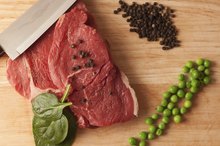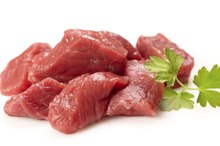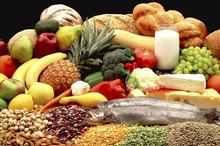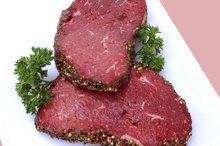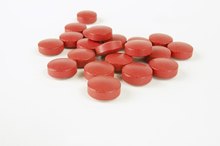What does fact checked mean?
At Healthfully, we strive to deliver objective content that is accurate and up-to-date. Our team periodically reviews articles in order to ensure content quality. The sources cited below consist of evidence from peer-reviewed journals, prominent medical organizations, academic associations, and government data.
The information contained on this site is for informational purposes only, and should not be used as a substitute for the advice of a professional health care provider. Please check with the appropriate physician regarding health questions and concerns. Although we strive to deliver accurate and up-to-date information, no guarantee to that effect is made.
How Much Iron a Mom Needs While Breastfeeding?
Iron transports oxygen throughout your body and is vitally important for everyone, but getting an adequate amount is of particular concern during pregnancy because of your body's higher demand for it. Although this demand drops significantly following childbirth, meeting intake recommendations is still essential -- especially if you plan to breastfeed. Not getting enough iron doesn't just affect your health; it also has repercussions for the health of your infant. Talk with your physician about how much is right for you.
Iron Needs
The amount of iron you need while breastfeeding depends on your age. If you are between the ages of 19 and 50, you need 6.5 milligrams, according to the Institute of Medicine 1. You need 7 milligrams a day if you're between the ages of 14 and 18. This is a substantial decrease from your iron need during pregnancy, which was 22 to 23 milligrams per day.
- The amount of iron you need while breastfeeding depends on your age.
Role of Iron
List of Foods & Drinks High in Iron
Learn More
Iron makes up part of the blood protein hemoglobin. During pregnancy, both you and your baby need iron for proper blood development. Your baby's body needs a store of the mineral after birth as well, further driving the increased demand during that time. After childbirth, iron is still important because of its role in oxygen transport, muscle function and cell development. Although breast milk does not contain a high amount of iron, your baby is able to more easily absorb the mineral from breast milk than other food sources, according to the University of Maryland Medical Center 23. If you met iron intake recommendations during pregnancy, your breast milk should supply enough iron to your baby to prevent deficiency for four to six months.
- Iron makes up part of the blood protein hemoglobin.
- Although breast milk does not contain a high amount of iron, your baby is able to more easily absorb the mineral from breast milk than other food sources, according to the University of Maryland Medical Center 2.
Effects of Deficiency
You may experience fatigue and be more prone to sickness due to iron deficiency. Feeling cold and having difficulty working are also common signs, according to the Linus Pauling Institute 4. Your baby's growth and development are also compromised if breast milk doesn't contain enough iron. Iron deficiency in early childhood causes the same effects. Your baby may have brittle nails, very pale skin, irritability, appetite loss and bloody stools. Not getting enough iron also negatively impacts your baby's cognitive function and motor skill development.
- You may experience fatigue and be more prone to sickness due to iron deficiency.
- Your baby's growth and development are also compromised if breast milk doesn't contain enough iron.
Food Sources
What Foods Are Low in Iron?
Learn More
While you may have needed a supplement during pregnancy, you likely can meet your iron needs through proper nutrition after childbirth. Oysters, lentils, tofu, beef and prune juice are good sources. Kidney beans, shrimp, cashews, dark meat chicken, tuna and potatoes with skin are also options. Many cereals are fortified with iron, containing up to 21 milligrams in just an ounce. Plant-based foods are non-heme sources of the mineral, so pair them with vitamin C sources to increase absorption, the Centers for Disease Control and Prevention recommends 5.
- While you may have needed a supplement during pregnancy, you likely can meet your iron needs through proper nutrition after childbirth.
- Oysters, lentils, tofu, beef and prune juice are good sources.
Related Articles
References
- University of Maryland Medical Center: Iron Deficiency Anemia - Children
- University of Maryland Medical Center: Anemia - Dietary Factors
- Linus Pauling Institute: Iron
- Centers for Disease Control and Prevention: Iron and Iron Deficiency
- Beard, J. L., Dawson, H., & Piñero, D. J. (1996). Iron metabolism: a comprehensive review. Nutrition Reviews, 54(10), 295-317.
- Trumbo, P., Yates, A. A., Schlicker, S., & Poos, M. (2001). Dietary reference intakes: Vitamin A, vitamin K, arsenic, boron, chromium, copper, iodine, iron, manganese, molybdenum, nickel, silicon, vanadium, and zinc. Journal of the Academy of Nutrition and Dietetics, 101(3), 294.
- Allen, L. H. (2000). Anemia and iron deficiency: effects on pregnancy outcome. The American Journal of Clinical Nutrition, 71(5), 1280s-1284s.
- Drukker, L., Hants, Y., Farkash, R., Ruchlemer, R., Samueloff, A., & GrisaruâGranovsky, S. (2015). Iron deficiency anemia at admission for labor and delivery is associated with an increased risk for Cesarean section and adverse maternal and neonatal outcomes. Transfusion, 55(12), 2799-2806.
- Miller, J. L. (2013). Iron deficiency anemia: a common and curable disease. Cold Spring Harbor Perspectives in Medicine, 3(7), a011866.
- Percy, L., Mansour, D., & Fraser, I. (2017). Iron deficiency and iron deficiency anaemia in women. Best Practice & Research Clinical Obstetrics & Gynaecology, 40, 55-67.
- Telford, R. D., Sly, G. J., Hahn, A. G., Cunningham, R. B., Bryant, C., & Smith, J. A. (2003). Footstrike is the major cause of hemolysis during running. Journal of Applied Physiology, 94(1), 38-42.
- Zoller, H., & Vogel, W. (2004). Iron supplementation in athletesâfirst do no harm. Nutrition, 20(7), 615-619.
- Collings, R., Harvey, L. J., Hooper, L., Hurst, R., Brown, T. J., Ansett, J., ... & Fairweather-Tait, S. J. (2013). The absorption of iron from whole diets: a systematic review. The American Journal of Clinical Nutrition, ajcn-050609.
Writer Bio
Previously working for the North Carolina Community College System, Rachel Morgan has been a freelance writer and editor for over six years. She has a bachelor's degree in public health as well as a master's degree in English.
